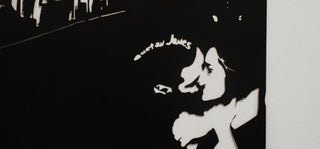Although James and Nimki have never been seen in the same room, they have a lot in common. From their choices of medium to the philosophies behind their work, the two artists seem to have been living almost parallel lives. After plenty of cajoling, Nimki permitted me access to an extract from their long-running correspondence which follows below; mutual admiration, shared history and the recent joint exhibition are discussed, and the two make plans to meet in the Congo – we’ll have to take their word for it.
Gatean James is a flaneur; for our Thurloe Place pop-up, he made a new series of limited edition paper cuts inspired by South Kensington, its residents and rhythms. An avid follower of James’ little-known oeuvre, Jacques Nimki created our headline commission, ‘Florilegium SW7’, accompanied by his own limited edition paper cut of flowers drawn from the flora of the meadow. Both are fascinated by the space between the quotidian and the extraordinary, pulling mundane subject matter into sharp relief by reframing it and, thereby, shifting its reception.






